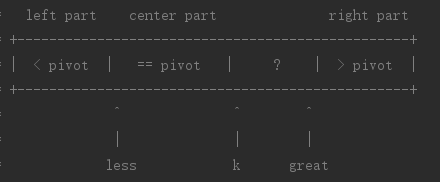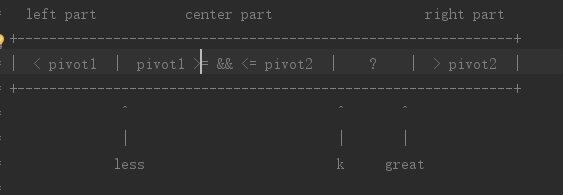Arrays.sort() ----- DualPivotQuicksort
Arrays.sort() ----- DualPivotQuicksort
DualPivotQuicksort是Arrays.sort()对基本类型的排序算法,它不止使用了双轴快速排序,还使用了TimSort、插入排序、成对插入排序、3-way快速排序。
算法介绍
成对插入排序

具体执行过程:
- 将要插入的数据,第一个值赋值a1,第二个值赋值a2
- 然后判断a1与a2的大小,使a1要大于a2
- 接下来,首先是插入大的数值a1,将a1与k之前的数字一一比较,直到数值小于a1为止,把a1插入到合适的位置,注意:比a1大的值右移2位
- 接下来,插入小的数值a2,将a2与此时k之前的数字一一比较,直到数值小于a2为止,将a2插入到合适的位置,注意:比a2大的值右移1位
- 最后把最后一个没有遍历到的数据插入到合适位置
3-way快速排序

具体执行过程:
- a[k] < pivot 交换a[less]和a[k],然后less和k都自增1,k继续扫描
- a[k] = pivot k自增1,k接着继续扫描
- a[k] > pivot 交换a[great]和a[k],但是我们不能直接将a[k]与a[great]交换,因为目前a[great]和pivot的关系未知,所以我们这个时候应该从great的位置自右向左扫描。而a[great]与pivot的关系可以继续分为三种情况讨论:
- a[great] > pivot great自减1,great接着继续扫描
- a[great] == pivot 交换a[k]和a[great],k自增1,great自减1,k继续扫描(注意此时great的扫描就结束了)
- a[great] < pivot: 此时我们注意到a[great] < pivot, a[k] > pivot, a[less] == pivot,那么我们只需要将a[great]放到a[less]上,a[k]放到a[great]上,而a[less]放到a[k]上。然后less和k自增1,great自减1,k继续扫描(注意此时great的扫描就结束了)
双轴快速排序

具体执行过程:
- a[k] < pivot1 less先自增,交换a[less]和a[k],k自增1,k接着继续扫描
- a[k] >= pivot1 && a[k] <= pivot2 k自增1,k接着继续扫描
- a[k] > pivot2: 这个时候显然a[k]应该放到最右端大于pivot2的部分。但此时,我们不能直接将a[k]与a[great]交换,因为目前a[great]和pivot1以及pivot2的关系未知,所以我们这个时候应该从great自右向左扫描。而a[great]与pivot1和pivot2的关系可以继续分为三种情况讨论
- a[great] > pivot2 j接着继续扫描
- a[great] >= pivot1且a[great] <= pivot2 交换a[k]和a[great],great自减1,k自增1,k继续扫描(注意此时great的扫描就结束了)
- a[great] < pivot1 先将i自增1,此时我们注意到a[great] < pivot1, a[k] > pivot2, pivot1 <= a[less] <=pivot2,那么我们只需要将a[great]放到a[less]上,a[k]放到a[great]上,而a[less]放到a[k]上。k自增1,great自减1,然后k继续扫描(此时great的扫描就结束了)
注意
- pivot1和pivot2在始终不参与k,greate扫描过程。
- 扫描结束时,a[less-1]表示了小于pivot1部分的最后一个元素,A[greate+1]表示了大于pivot2的第一个元素,这时我们只需要交换pivot1(即A[L])和A[less-1],交换pivot2(即A[R])与A[greate+1],同时我们可以确定A[less-1]和A[greate+1]所在的位置在后续的排序过程中不会发生变化(这一步非常重要,否则可能引起无限递归导致的栈溢出),最后我们只需要对A[L, less-2],A[less, great],A[great+1, R]这三个部分继续递归上述操作即可。
TimSort
TimSort可以看另一篇文章:Arrays.sort() ----- TimSort
jdk1.8源码
static void sort(int[] a, int left, int right,
int[] work, int workBase, int workLen) {
// Use Quicksort on small arrays
if (right - left < QUICKSORT_THRESHOLD) {
sort(a, left, right, true);
return;
}
//大于阈值使用阉割版的TimSort,去掉了自适应
........
}
private static void sort(int[] a, int left, int right, boolean leftmost) {
int length = right - left + 1;
// 小于一个阈值的使用插入排序
if (length < INSERTION_SORT_THRESHOLD) {
if (leftmost) {//位于整个数组最左边,使用传统插入排序
for (int i = left, j = i; i < right; j = ++i) {
int ai = a[i + 1];
while (ai < a[j]) {
a[j + 1] = a[j];
if (j-- == left) {
break;
}
}
a[j + 1] = ai;
}
} else {//成对插入排序
/*
* 跳过左边已排序的部分
*/
do {
if (left >= right) {
return;
}
} while (a[++left] >= a[left - 1]);
/*
* Every element from adjoining part plays the role
* of sentinel, therefore this allows us to avoid the
* left range check on each iteration. Moreover, we use
* the more optimized algorithm, so called pair insertion
* sort, which is faster (in the context of Quicksort)
* than traditional implementation of insertion sort.
*/
for (int k = left; ++left <= right; k = ++left) {
int a1 = a[k], a2 = a[left];
if (a1 < a2) {
a2 = a1; a1 = a[left];
}
while (a1 < a[--k]) {
a[k + 2] = a[k];
}
a[++k + 1] = a1;
while (a2 < a[--k]) {
a[k + 1] = a[k];
}
a[k + 1] = a2;
}
int last = a[right];
while (last < a[--right]) {
a[right + 1] = a[right];
}
a[right + 1] = last;
}
return;
}
// Inexpensive approximation of length / 7
int seventh = (length >> 3) + (length >> 6) + 1;
/*
* Sort five evenly spaced elements around (and including) the
* center element in the range. These elements will be used for
* pivot selection as described below. The choice for spacing
* these elements was empirically determined to work well on
* a wide variety of inputs.
*/
int e3 = (left + right) >>> 1; // The midpoint
int e2 = e3 - seventh;
int e1 = e2 - seventh;
int e4 = e3 + seventh;
int e5 = e4 + seventh;
// Sort these elements using insertion sort
if (a[e2] < a[e1]) { int t = a[e2]; a[e2] = a[e1]; a[e1] = t; }
if (a[e3] < a[e2]) { int t = a[e3]; a[e3] = a[e2]; a[e2] = t;
if (t < a[e1]) { a[e2] = a[e1]; a[e1] = t; }
}
if (a[e4] < a[e3]) { int t = a[e4]; a[e4] = a[e3]; a[e3] = t;
if (t < a[e2]) { a[e3] = a[e2]; a[e2] = t;
if (t < a[e1]) { a[e2] = a[e1]; a[e1] = t; }
}
}
if (a[e5] < a[e4]) { int t = a[e5]; a[e5] = a[e4]; a[e4] = t;
if (t < a[e3]) { a[e4] = a[e3]; a[e3] = t;
if (t < a[e2]) { a[e3] = a[e2]; a[e2] = t;
if (t < a[e1]) { a[e2] = a[e1]; a[e1] = t; }
}
}
}
// Pointers
int less = left; // The index of the first element of center part
int great = right; // The index before the first element of right part
if (a[e1] != a[e2] && a[e2] != a[e3] && a[e3] != a[e4] && a[e4] != a[e5]) {//双轴快速排序
/*
* Use the second and fourth of the five sorted elements as pivots.
* These values are inexpensive approximations of the first and
* second terciles of the array. Note that pivot1 <= pivot2.
*/
int pivot1 = a[e2];
int pivot2 = a[e4];
/*
* The first and the last elements to be sorted are moved to the
* locations formerly occupied by the pivots. When partitioning
* is complete, the pivots are swapped back into their final
* positions, and excluded from subsequent sorting.
*/
a[e2] = a[left];
a[e4] = a[right];
/*
* Skip elements, which are less or greater than pivot values.
*/
while (a[++less] < pivot1);
while (a[--great] > pivot2);
/*
* Partitioning:
*
* left part center part right part
* +--------------------------------------------------------------+
* | < pivot1 | pivot1 <= && <= pivot2 | ? | > pivot2 |
* +--------------------------------------------------------------+
* ^ ^ ^
* | | |
* less k great
*
* Invariants:
*
* all in (left, less) < pivot1
* pivot1 <= all in [less, k) <= pivot2
* all in (great, right) > pivot2
*
* Pointer k is the first index of ?-part.
*/
outer:
for (int k = less - 1; ++k <= great; ) {
int ak = a[k];
if (ak < pivot1) { // Move a[k] to left part
a[k] = a[less];
/*
* Here and below we use "a[i] = b; i++;" instead
* of "a[i++] = b;" due to performance issue.
*/
a[less] = ak;
++less;
} else if (ak > pivot2) { // Move a[k] to right part
while (a[great] > pivot2) {
if (great-- == k) {
break outer;
}
}
if (a[great] < pivot1) { // a[great] <= pivot2
a[k] = a[less];
a[less] = a[great];
++less;
} else { // pivot1 <= a[great] <= pivot2
a[k] = a[great];
}
/*
* Here and below we use "a[i] = b; i--;" instead
* of "a[i--] = b;" due to performance issue.
*/
a[great] = ak;
--great;
}
}
// Swap pivots into their final positions
a[left] = a[less - 1]; a[less - 1] = pivot1;
a[right] = a[great + 1]; a[great + 1] = pivot2;
// Sort left and right parts recursively, excluding known pivots
sort(a, left, less - 2, leftmost);
sort(a, great + 2, right, false);
//如果中间区域太大,使用双轴的思想,优化中间区域
if (less < e1 && e5 < great) {
/*
* Skip elements, which are equal to pivot values.
*/
while (a[less] == pivot1) {
++less;
}
while (a[great] == pivot2) {
--great;
}
/*
* Partitioning:
*
* left part center part right part
* +----------------------------------------------------------+
* | == pivot1 | pivot1 < && < pivot2 | ? | == pivot2 |
* +----------------------------------------------------------+
* ^ ^ ^
* | | |
* less k great
*
* Invariants:
*
* all in (*, less) == pivot1
* pivot1 < all in [less, k) < pivot2
* all in (great, *) == pivot2
*
* Pointer k is the first index of ?-part.
*/
outer:
for (int k = less - 1; ++k <= great; ) {
int ak = a[k];
if (ak == pivot1) { // Move a[k] to left part
a[k] = a[less];
a[less] = ak;
++less;
} else if (ak == pivot2) { // Move a[k] to right part
while (a[great] == pivot2) {
if (great-- == k) {
break outer;
}
}
if (a[great] == pivot1) { // a[great] < pivot2
a[k] = a[less];
/*
* Even though a[great] equals to pivot1, the
* assignment a[less] = pivot1 may be incorrect,
* if a[great] and pivot1 are floating-point zeros
* of different signs. Therefore in float and
* double sorting methods we have to use more
* accurate assignment a[less] = a[great].
*/
a[less] = pivot1;
++less;
} else { // pivot1 < a[great] < pivot2
a[k] = a[great];
}
a[great] = ak;
--great;
}
}
}
// Sort center part recursively
sort(a, less, great, false);
} else { //使用3-ways快速排序
/*
* Use the third of the five sorted elements as pivot.
* This value is inexpensive approximation of the median.
*/
int pivot = a[e3];
/*
* Partitioning degenerates to the traditional 3-way
* (or "Dutch National Flag") schema:
*
* left part center part right part
* +-------------------------------------------------+
* | < pivot | == pivot | ? | > pivot |
* +-------------------------------------------------+
* ^ ^ ^
* | | |
* less k great
*
* Invariants:
*
* all in (left, less) < pivot
* all in [less, k) == pivot
* all in (great, right) > pivot
*
* Pointer k is the first index of ?-part.
*/
for (int k = less; k <= great; ++k) {
if (a[k] == pivot) {
continue;
}
int ak = a[k];
if (ak < pivot) { // Move a[k] to left part
a[k] = a[less];
a[less] = ak;
++less;
} else { // a[k] > pivot - Move a[k] to right part
while (a[great] > pivot) {
--great;
}
if (a[great] < pivot) { // a[great] <= pivot
a[k] = a[less];
a[less] = a[great];
++less;
} else { // a[great] == pivot
/*
* Even though a[great] equals to pivot, the
* assignment a[k] = pivot may be incorrect,
* if a[great] and pivot are floating-point
* zeros of different signs. Therefore in float
* and double sorting methods we have to use
* more accurate assignment a[k] = a[great].
*/
a[k] = pivot;
}
a[great] = ak;
--great;
}
}
/*
* Sort left and right parts recursively.
* All elements from center part are equal
* and, therefore, already sorted.
*/
sort(a, left, less - 1, leftmost);
sort(a, great + 1, right, false);
}
}
参考资料
https://www.cnblogs.com/nullzx/p/5880191.html
https://www.jianshu.com/p/6d26d525bb96
Arrays.sort() ----- DualPivotQuicksort的更多相关文章
- 关于Java中Arrays.sort()方法TLE
最近一直在练用Java写题,今天无意发现一道很简单的二分题(链接),我一开始是直接开int[]数组调用Arrays.sort()去排序,没想到TLE了,原来是因为jdk中对于int[]的排序是使用快速 ...
- Arrays.sort解析
Arrays.sort()解读 在学习了排序算法之后, 再来看看 Java 源码中的, Arrays.sort() 方法对于排序的实现. 都是对基本数据类型的排序实现, 下面来看看这段代码: Arra ...
- Java 容器 & 泛型:四、Colletions.sort 和 Arrays.sort 的算法
Writer:BYSocket(泥沙砖瓦浆木匠) 微博:BYSocket 豆瓣:BYSocket 本来准备讲 Map集合 ,还是喜欢学到哪里总结吧.最近面试期准备准备,我是一员,成功被阿里在线笔试秒杀 ...
- JAVA基础系列:Arrays.sort()
JDK 1.8 java.util.Arrays.class(rt.jar) 1. Collections.sort方法底层就是调用的Arrays.sort方法. 2. Java Arrays中提供 ...
- Arrays.sort() ----- TimSort
Arrays.sort() Arrays.sort()对于基本类型使用的是DualPivotQuicksort双轴快速排序,而对于非基本类型使用的是TimSort,一种源自合并排序和插入排序的混合稳定 ...
- Arrays.Sort()中的那些排序算法
本文基于JDK 1.8.0_211撰写,基于java.util.Arrays.sort()方法浅谈目前Java所用到的排序算法,仅个人见解和笔记,若有问题欢迎指证,着重介绍其中的TimSort排序,其 ...
- 关于Java中Collections.sort和Arrays.sort的稳定性问题
一 问题的提出 关于Java中Collections.sort和Arrays.sort的使用,需要注意的是,在本文中,比较的只有Collections.sort(List<T> ele ...
- Arrays.sort(arr)是什么排序
在学习过程中观察到Arrays.sort(arr)算法可以直接进行排序,但不清楚底层的代码逻辑是什么样子,记得自己之前在面试题里面也有面试官问这个问题,只能说研究之后发现还是比较复杂的,并不是网上说的 ...
- java源码分析:Arrays.sort
仔细分析java的Arrays.sort(version 1.71, 04/21/06)后发现,java对primitive(int,float等原型数据)数组采用快速排序,对Object对象数组采用 ...
随机推荐
- 1.尚硅谷_MyBatis_简介.avi
hibernate旨在消除mysql语句.程序员不写sql语言,要实现复杂的功能需要学习hibernate的hql语句 mybatis把编写sql语言交给程序员,程序员自己在xml控制sql语句的编写 ...
- python 类(object)的内置函数
python 类(object)的内置函数 # python 类(object)的内置函数 ### 首先 #### 以__双下划线开头的内置函数 __ #### __往往会在某些时候被自动调用,例如之 ...
- 【MonogDB帮助类】
using System; using System.Collections.Generic; using System.Linq; using System.Web; using MongoDB; ...
- 深入探究ASP.NET Core异常处理中间件
前言 全局异常处理是我们编程过程中不可或缺的重要环节.有了全局异常处理机制给我们带来了很多便捷,首先我们不用满屏幕处理程序可能出现的异常,其次我们可以对异常进行统一的处理,比如收集异常信息或者 ...
- max depth exceeded when dereferencing c0-param0问题的解决
在做项目的时候,用到了dwr,有一次居然报错,错误是 max depth exceeded when dereferencing c0-param0 上网查了一下,我居然传参数的时候传的是object ...
- hive中标准偏差函数stddev()详细讲解
1.标准偏差概念 标准偏差(Std Dev,Standard Deviation) -统计学名词.一种度量数据分布的分散程度之标准,用以衡量数据值偏离算术平均值的程度.标准偏差越小,这些值偏离平均值就 ...
- json自定制
import json from datetime import date from datetime import datetime class JsonCustomEncoder(json.JSO ...
- 每日一题 - 剑指 Offer 41. 数据流中的中位数
题目信息 时间: 2019-06-30 题目链接:Leetcode tag: 大根堆 小根堆 难易程度:中等 题目描述: 如何得到一个数据流中的中位数?如果从数据流中读出奇数个数值,那么中位数就是所有 ...
- Vue-base64移动端PDF展示
作为一个后端开发,写前端的一些功能也是头大,好在网友强大,网上资源比较多:做一个移动端PDF预览的功能,本来可以通过window.open(),打开的,但是没办法,做后台的小伙伴,传给前端的数据是ba ...
- 简单的MVC框架
效果图: 源码下载:https://github.com/doyoulaikeme/DotNetSample/tree/master/DotNetSample4/easyMVCFramework
